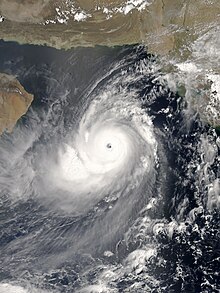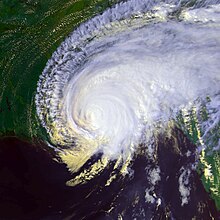The Tropical Cyclones Portal

A tropical cyclone is a storm system characterized by a large low-pressure center, a closed low-level circulation and a spiral arrangement of numerous thunderstorms that produce strong winds and heavy rainfall. Tropical cyclones feed on the heat released when moist air rises, resulting in condensation of water vapor contained in the moist air. They are fueled by a different heat mechanism than other cyclonic windstorms such as Nor'easters, European windstorms and polar lows, leading to their classification as "warm core" storm systems. Most tropical cyclones originate in the doldrums, approximately ten degrees from the Equator.
The term "tropical" refers to both the geographic origin of these systems, which form almost exclusively in tropical regions of the globe, as well as to their formation in maritime tropical air masses. The term "cyclone" refers to such storms' cyclonic nature, with anticlockwise rotation in the Northern Hemisphere and clockwise rotation in the Southern Hemisphere. Depending on its location and intensity, a tropical cyclone may be referred to by names such as "hurricane", "typhoon", "tropical storm", "cyclonic storm", "tropical depression" or simply "cyclone".
Types of cyclone: 1. A "Typhoon" is a tropical cyclone located in the North-west Pacific Ocean which has the most cyclonic activity and storms occur year-round. 2. A "Hurricane" is also a tropical cyclone located at the North Atlantic Ocean or North-east Pacific Ocean which have an average storm activity and storms typically form between May 15 and November 30. 3. A "Cyclone" is a tropical cyclone that occurs in the South Pacific and Indian Oceans.
Selected named cyclone -
Super Cyclonic Storm Gonu was an extremely powerful tropical cyclone that became the strongest cyclone on record in the Arabian Sea. The second named tropical cyclone of the 2007 North Indian Ocean cyclone season, Gonu developed from a persistent area of convection in the eastern Arabian Sea on June 1, 2007. With a favorable upper-level environment and warm sea surface temperatures, it rapidly intensified to attain peak winds of 240 km/h (150 mph) on June 4, according to the India Meteorological Department. Gonu weakened after encountering dry air and cooler waters, and early on June 6, it made landfall on the easternmost tip of Oman, becoming the strongest tropical cyclone to hit the Arabian Peninsula. It then turned northward into the Gulf of Oman, and dissipated on June 7, after making landfall in southern Iran, the first landfall in the country since 1898.
Intense tropical cyclones like Gonu are extremely rare in the Arabian Sea, and most storms in this area tend to be small and dissipate quickly. The cyclone caused 50 deaths and about $4.2 billion in damage (2007 USD) in Oman, where the cyclone was considered the nation's worst natural disaster. Gonu dropped heavy rainfall near the eastern coastline, reaching up to 610 mm (24 inches), which caused flooding and heavy damage. In Iran, the cyclone caused 28 deaths and $216 million in damage (2007 USD). (Full article...)
Selected article -
The effects of Hurricane Georges in Louisiana included $30.1 million in damage and three deaths. Forming from a tropical wave over the Atlantic Ocean, Georges attained a peak intensity of 155 mph (249 km/h) on September 20, 1998. Over the following several days, the storm tracked through the Greater Antilles and later entered the Gulf of Mexico on September 28, the Category 2 storm made landfall in Mississippi before dissipating on October 1. Before landfall, about 500,000 residents in Louisiana evacuated from low-lying areas. The mayor of New Orleans declared a state of emergency to allow federal assistance into the state. After nearly 1.5 million people were urged to evacuate coastal areas, officials described the evacuation as "probably the largest [...] we have ever achieved".
Numerous homes located outside the levee system were flooded by the storm surge, and 85 fishing camps on the banks of Lake Pontchartrain were destroyed. An estimated 160,000 residences were left without power due to Georges and severe beach erosion took place due to the slow movement of the hurricane. Precipitation statewide peaked at 2.98 inches (76 mm) in Bogalusa, and wind gusts reached 82 mph (132 km/h). In the wake of the hurricane, the Federal Emergency Management Agency (FEMA) opened 67 shelters throughout the state, and covered insurance claims totalling $14,150,532, including from Puerto Rico and Mississippi. The Clinton administration appropriated $56 million in disaster relief to regions in Louisiana for recovery from Tropical Storm Frances and Hurricane Georges. (Full article...)
Selected image -

Selected season -

The 2013 North Indian Ocean cyclone season was an event in the annual cycle of tropical cyclone formation, in which tropical cyclones formed in the North Indian Ocean and Arabian Sea. The season had no official bounds, but cyclones typically formed between May and December, with the peak from October to November. These dates conventionally delimit the period of each year when most tropical cyclones form in the northern Indian Ocean.
The scope of this article is limited to the Indian Ocean in the Northern Hemisphere, east of the Horn of Africa and west of the Malay Peninsula. There are two main seas in the North Indian Ocean — the Arabian Sea to the west of the Indian subcontinent, abbreviated ARB by the India Meteorological Department (IMD); and the Bay of Bengal to the east, abbreviated BOB by the IMD. (Full article...)
Related portals
Currently active tropical cyclones

Italicized basins are unofficial.
- North Indian Ocean (2024)
- No active systems
- Mediterranean (2024–25)
- No active systems
- Australian region (2024–25)
- No active systems
- South Pacific (2024–25)
- No active systems
- South Atlantic (2024–25)
- No active systems
Last updated: 15:26, 2 October 2024 (UTC)
Tropical cyclone anniversaries

October 1
- 1976 - Hurricane Liza brushed the south of the Baja California peninsula in Mexico at its peak intensity, killing over 600 people in La Paz.
- 1986 - Hurricane Paine (pictured) reaches peak intensity just before making landfall in Sonora.
- 2004 - Cyclone Onil becomes the first tropical cyclone to be named by the IMD within the North Indian Ocean basin.

October 2
- 1858 - The 1858 San Diego hurricane passed just to the west of San Diego, California, bringing heavy rain and powerful winds to the city. It is the only tropical cyclone ever recorded to directly affect the state as a hurricane.
- 2014 - Typhoon Phanfone (pictured) peaked as a Category 4 super typhoon, with 1-minute sustained winds of 255 km/h (155 mph), a few days before re-curving to Japan, and caused a total of $100 million in damage and killed 11 people.

October 3
- 1963 - Hurricane Flora reached its peak as a Category 4 hurricane with 225 km/h (140 mph) winds in the Caribbean Sea. Flora killed over 7,000 people, mostly in Cuba and Haiti as a result of excessive rainfall.
- 2015 - Hurricane Joaquin (pictured) reaches peak intensity as a high-end Category 4 hurricane, after impacting the Bahamas.
Did you know…




- …that the Joint Typhoon Warning Center considers that Typhoon Vera (pictured) of 1986 is actually two distinct systems, formed from two separated low-level circulations?
- …that Cyclone Freddy (track pictured) in 2023 was the longest-lasting tropical cyclone worldwide?
- …that Cyclone Raquel (track pictured) travelled between the Australian and South Pacific basins between the 2014–15 and 2015–16 seasons, spanning both seasons in both basins?
- …that Hurricane Otis (pictured) in 2023 was the first Pacific hurricane to make landfall at Category 5 intensity and surpassed Hurricane Patricia as the strongest landfalling Pacific hurricane on record?
General images -

Between 1900 and 1949, 108 Atlantic hurricanes have affected the U.S. state of Florida. Collectively, tropical cyclones in Florida during the time period resulted in about $4 billion (2008 USD) in damage. Additionally, tropical cyclones in Florida were directly responsible for about 3,550 fatalities during the time period, most of which from the 1928 Okeechobee Hurricane. The 1947 season was the year with the most tropical cyclones affecting the state, with a total of 6 systems. The 1905, 1908, 1913, 1927, 1931, 1942, and 1943 seasons were the only years during the time period in which a storm did not affect the Floridan coasts.
The strongest hurricane to hit the state during the time period was the 1935 Labor Day hurricane, which also bears the distinction of being the strongest recorded hurricane to strike the United States. Several other major hurricanes struck the state during the time period, including the 1926 Miami hurricane, the 1928 Okeechobee hurricane, and a cyclone each in 1945, 1947, 1948, and 1949. All of these storms made landfall as Category 4 hurricanes. (Full article...)
Topics
Subcategories
Related WikiProjects
WikiProject Tropical cyclones is the central point of coordination for Wikipedia's coverage of tropical cyclones. Feel free to help!
WikiProject Weather is the main center point of coordination for Wikipedia's coverage of meteorology in general, and the parent project of WikiProject Tropical cyclones. Three other branches of WikiProject Weather in particular share significant overlaps with WikiProject Tropical cyclones:
- The Non-tropical storms task force coordinates most of Wikipedia's coverage on extratropical cyclones, which tropical cyclones often transition into near the end of their lifespan.
- The Floods task force takes on the scope of flooding events all over the world, with rainfall from tropical cyclones a significant factor in many of them.
- WikiProject Severe weather documents the effects of extreme weather such as tornadoes, which landfalling tropical cyclones can produce.
Things you can do
 |
Here are some tasks awaiting attention:
|
Wikimedia
The following Wikimedia Foundation sister projects provide more on this subject:
-
Commons
Free media repository -
Wikibooks
Free textbooks and manuals -
Wikidata
Free knowledge base -
Wikinews
Free-content news -
Wikiquote
Collection of quotations -
Wikisource
Free-content library -
Wikiversity
Free learning tools -
Wikivoyage
Free travel guide -
Wiktionary
Dictionary and thesaurus
























































